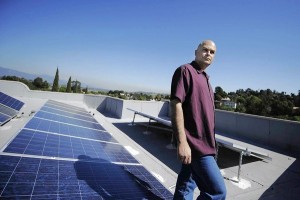
At least two dozen solar, wind and other energy projects currently tangled in bureaucratic and environmental red tape could give California a multibillion dollar boost if they were to move forward, a new report says.
The study, commissioned by the U.S. Chamber of Commerce, estimates that building and operating 31 stalled energy projects in the state would create 142,100 jobs annually and pump nearly $60 billion into the economy.The report was unveiled as gas prices continued to climb and calls for cleaner sources of energy have been rising.“We have hundreds of laws with thousands of provisions, all of which can stop a project,” said William Kovacs, the U.S. chamber’s senior vice president of environment, technology and regulatory affairs. “As you delay these projects, you put them at economic risk.”
Few analysts disagreed with the potential economic effect but some cautioned that regulations are needed to guide and protect against inexperienced developers and potentially risky projects, both common in the rapidly changing alternative energy industry.“You have to be careful to not cast aside 40 years of environmental law in the name of short-term economic gain,” said Christine Hersey, a solar analyst at Wedbush Securities.
Nationwide, the study looked at 351 projects that have been held up. They included solar, wind, wave, biofuel, coal, gas and nuclear energy production facilities, as well as planned energy transmission lines needed to link far-flung projects to urban centers. Nearly half are considered renewable energy.
If constructed, the report said the projects could give the U.S. economy a $1.1-trillion short-term boost and create 1.9 million jobs a year. With many projects planning to operate for at least 20 years, the study estimated that the full potential economic effect could be more than $3.4 trillion. The nation’s gross domestic product, or the value goods and services, was $14.3 trillion in 2009.Those figures don’t include what the effect would have been if projects scaled back to meet regulatory requirements remained at their original, proposed size.
The study found that complex regulatory processes, tortured permitting requirements and not- in-my-backyard-style activism caused many of the delays. Lawsuits have been filed and protests staged against solar and wind projects, accusing them of endangering birds, blocking radar and trampling on native species and Indian burial grounds.
At the same time, many local government agencies have had to deal with major budget cuts that have slowed the permitting process, Hersey said.
“The scale and scope of some of these projects — you’re talking thousands of acres — is unprecedented,” she said. “Their workload has quadrupled during this renewable energy gold rush.”
Some proposals had powerful backers with pockets deep enough to endure the delays. But typically, many of the projects have seen their funds run dry and their investors flee because of the holdup, researchers said.
In March, citing escalating costs after a string of revisions and persistent environmentalist backlash, the Los Angeles Department of Water and Power abandoned its plans for the Green Path North transmission line that would have run through San Bernardino County to funnel renewable power to the city.Sheila Bowers, an environmental activist, argued that growth and construction in any industry, not just energy, would lead to jobs and economic gain. But that’s not always a viable, long-term option, she added.“If the entire desert was built up like Las Vegas, that would be an economic boom too,” she said. “But we can’t work that way for a thousand reasons.”
Bowers, who supports local small-scale renewable power, said that building the rooftop and community solar installations known as distributed generation is much more efficient and creates more stable jobs than massive, utility-size facilities.
“We should move more toward an energy model that’s like the Internet — dynamic, fast, democratic and decentralized,” she said.Since the study data were collected in March, some projects have moved forward such as the Sunrise Powerlink, a San Diego Gas & Electric transmission line that spent years wallowing in permitting and litigation — some of which are still ongoing.Even if the regulatory process is untangled, not all projects are worth completing, researchers said.
“I’m sure there are some real stinkers in here,” said Steve Pociask, president of TeleNomic Research, an economic research firm that produced the study with Widener University economics professor Joseph Fuhr Jr.Still, many worthwhile projects are lagging, said Peter Morici, former chief economist of the U.S. International Trade Commission, who helped the chamber review the report.
“We have to get on with these kinds of things,” he said. “We’re shooting ourselves in the foot.”






